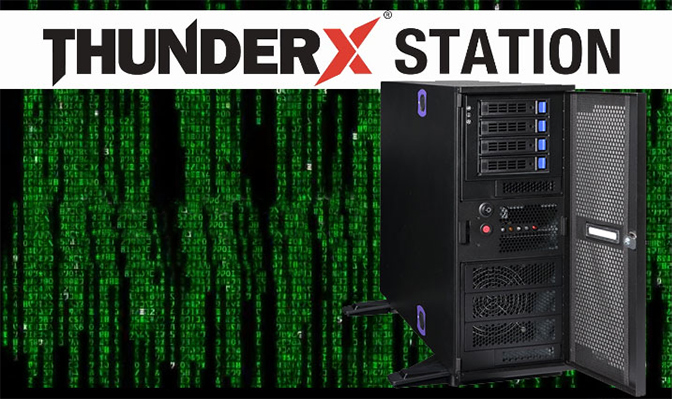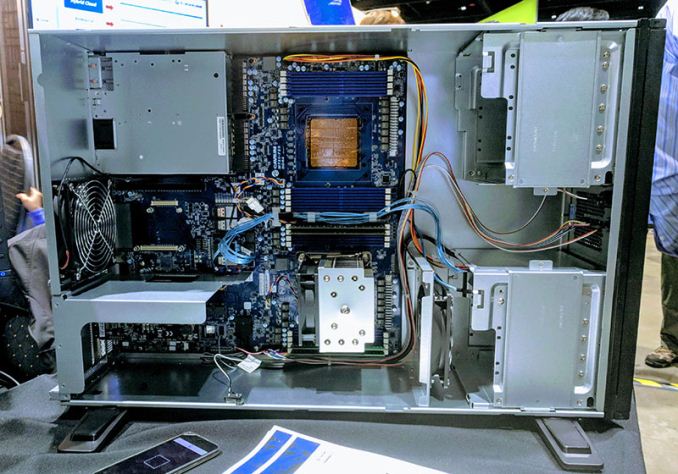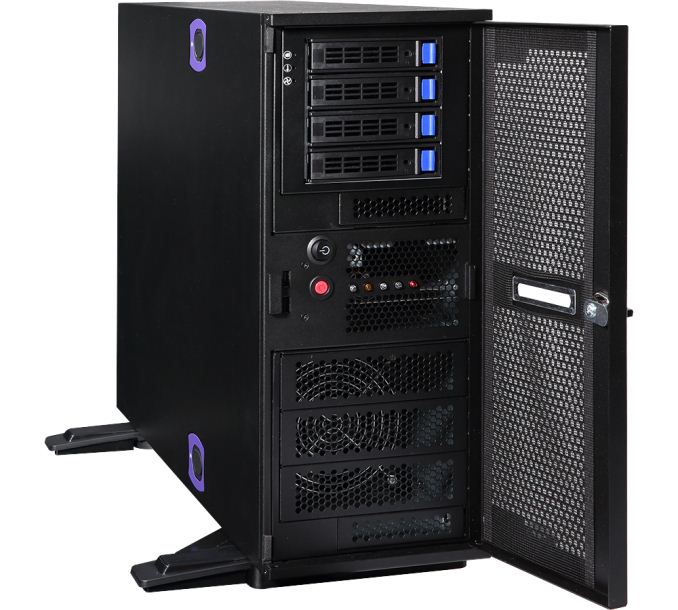GIGABYTE's ThunderXStation with Dual Cavium ThunderX2 Arm SoCs
by Anton Shilov on March 27, 2018 7:30 AM EST- Posted in
- Workstation
- Systems
- Gigabyte
- Arm
- ARMv8
- Cavium
- ThunderX
- ThunderXStation

GIGABYTE this month introduced its ThunderXStation workstation based on two Cavium ThunderX2 processors featuring Armv8 architecture. The machine is primarily aimed at software developers porting or developing various applications to Armv8 platforms. The ThunderXStation is already available in the US.
GIGABYTE's ThunderXStation (W281-T90) comes in 4U tower and is based on a dual-socket motherboard supporting Cavium’s ThunderX2 SoCs featuring up to 64 custom Armv8 cores with four-way SMT as well as 16 DDR4 memory channels (1DPC, 8 channels per SoC) when two CPUs are installed. A dual-processor ThunderXStation comes with two PCIe Gen3/OCP x16 slots, four PCIe Gen3 slots (two x16 and two x8), four M.2 (NVMe/PCIe 3.0 x4) slots for SSDs, two U.2/SATA 2.5” bays for SSDs/HDDs, two 10 GbE/GbE QLogic NICs, NVIDIA’s GeForce GT 710 GPU, an 800 W redundant PSU and so on.

Image from ServeTheHome from OCP Summit 2018
From hardware standpoint, the ThunderXStation looks rather versatile: it supports various expansion slots, enabling developers to use various add-on cards, accelerators, and storage devices required by their applications. The system also has an Aspeed AST2500 server management chip to bring it even closer to target machines that will run the ThunderX2.
The ThunderXStation ships with Ubuntu 17.10 OS, but can come with CentOS 7.4 or OpenSUSE, if required. It also comes with preinstalled software development tools, including gcc 7.2, LLVM, gdb, Golang, OpenJDK 9.0, HHVM, Python, PHP, Ruby etc. The OS supports KVM and Docket to enable developers to test their apps in hypervisor-based or containerized environments. The machine ships with open sources graphics drivers, primarily because it comes with a GeForce GT 710 graphics card (so, open source drivers should be reasonably good for such an old architecture).
| GIGABYTE's ThunderXStation | |
| Preliminary Specifications | |
| CPU | Dual or single Cavium ThunderX2 2.2 GHz CPU with 32 cores |
| GPU | NVIDIA GeForce GT 710 |
| Memory | 8 × DDR4-2666 DIMM slots per CPU |
| Storage | 2 × M.2 slots for PCIe/NVMe SSDs |
| 2 × 2.5" SATA/U.2 bays | |
| Wireless | unknown/none |
| Ethernet | 1 × Gigabit Ethernet, can be outfitted with 10 GbE cards |
| PCIe | 1 × PCIe Gen 3/OCP x16 per CPU 2 × x16/x8/x4/x1 and x8 per CPU |
| Display Outputs | 1 × D-Sub for management Others via discrete graphics |
| Audio | unknown |
| USB | 4 × USB 3.0 Type-A |
| PSU | 800 W redundant |
| OS | Ubuntu 17.10. CentOS 7.4 or OpenSUSE |
One of the reasons why contemporary Armv8 SoCs are rarely used in datacenters is lack of software support. Developers need to recompile their programs for Arm, but since very few have access to hardware and appropriate tools, the software porting process is proceeding very slowly. GIGABYTE’s ThunderXStation will enable more parties to work on server programs for Arm platforms. This is similar to how Intel approached the Xeon Phi ecosystem, by launching a tower equivalent with a Knights Landing machine with the Xeon Phi chip as the host for development work.
The Armv8-based workstation for software developers is now available from PhoenicsElectronics in the U.S. GIGABYTE does not publish pricing of the ThunderXStation, but we have reached out to PhoenicsElectronics and will update the story once we get more information on the matter.
Related Reading
- Marvell to Acquire Cavium for $5.5 Billion, Augmenting Marvell's CPU, Networking, & Security Assets
- Investigating Cavium's ThunderX: The First Arm Server SoC With Ambition
- AppliedMicro's X-Gene 3 SoC Begins Sampling: A Step in Arm's 2017 Server Ambitions
- MACOM Sells AppliedMicro’s X-Gene CPU Business
- Arm Challenging Intel in the Server Market: An Overview
- Supermicro Releases Intel Xeon Phi x200 (KNL) Systems: Servers and a Developer Mid-Tower
Sources: Cavium, ThunderXForums, Liliputing











23 Comments
View All Comments
Elstar - Tuesday, March 27, 2018 - link
Right, and a specific kind of ARM development too: People that are planning on creating or supporting large ARM server deployments, and they want a "quiet" version of the rack mount hardware in their office for testing/debugging.AntonErtl - Tuesday, March 27, 2018 - link
Why not GT710? Because Nvidia does not support free (aka open-source) software, and all the free drivers there are for Nvidia are thanks to reverse engineering (note that the proprietary Nvidia drivers for Linux do not work on ARM). By contrast, AMD has been supporting free software by providing hardware info, and by writing free Linux drivers themselves for many years. So when selecting a graphics card for our new servers last year, we picked the Radeon R5 230, and that has worked nicely.ZeDestructor - Tuesday, March 27, 2018 - link
Linux for Tegra, now Vibrante are nV-supplied Linux on ARMv8 distros for their Tegra platforms. Amongst the various bits included, there are official, Linux-compatible ARMv8 drivers included. In addition to that, nV currently ships a Linux 32bit ARM (ARMv7, I suspect) officially from nvidia.com.Going from there, I'd say it's just a matter of consumer demand before there's a matching official ARMv8 generic Linux driver for it. Assuming their new open-source efforts don't just actually happen and make it all pointless.